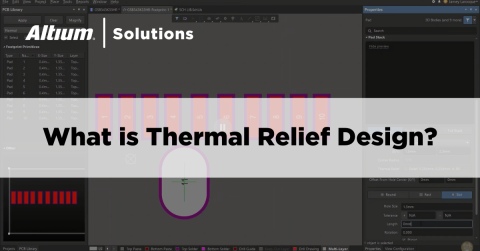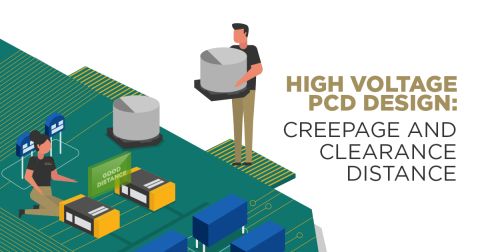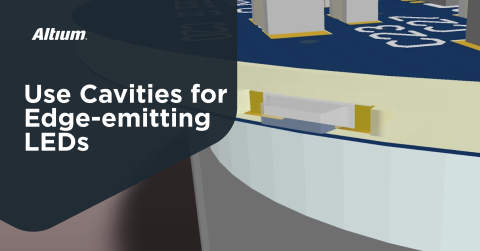Thermal Management: Designing Aircraft Avionics Cooling Systems

The physical and electrical demands on PCBs in avionics systems are among the most intense in all engineering fields. These systems must withstand significant mechanical demands while remaining within an acceptable temperature range. Within aerospace engineering, design techniques for thermal management for avionics systems is an active area of development as more mechanical systems are replaced with equivalent electronic systems.
In addition to the thermal demands for avionics systems, PCBs for these systems must meet specific design and manufacturability standards that help ensure quality and reliability. The best way to ensure your thermal management systems meet these important standards is to work with the best PCB design and analysis software. When you work with Altium Designer, you’ll have access to the tools you need to design your avionics systems for thermal management to important industry standards and verify the functionality of your system using power analysis tools.
ALTIUM DESIGNER®
A unified PCB design package that integrates advanced PCB design and layout features with comprehensive components libraries and production planning features.
Thermal management of avionics systems is one of the primary factors that limits the effectiveness and lifetime of these systems. Similar to other electronic systems, avionics systems can reach very high temperatures during operation, which limits the lifetime of components and places stress on PCBs during operation. As more mechanical systems are replaced with equivalent electronic systems, these new electronic systems must be designed to withstand extreme thermal and mechanical demands. This includes cycling between large temperature ranges, as well as mechanical shock and vibration during sustained maneuvers.
The move to replace mechanical systems with electronics systems is driven by the need for systems that use less power, have lower mass and volume, and integrate diverse functionality. New thermal management systems are among the most important avionics systems that will be seen on new aircraft. The need for creative thermal management provides plenty of engineering opportunities for PCB designers and electromechanical designers alike.
Meeting these important requirements for any aerospace system takes adaptable design software for any application. The goal of cooling systems design is to encourage heat transfer away from critical components and dissipate it into the external environment. Among the many possible thermal management techniques that can be used for PCBs, different passive and active heat transfer techniques can be used along with natural convection to efficiently remove heat and keep important systems within acceptable operating limits.
Avionics and Military Electronics Thermal Management Challenges
The challenges in electronics systems and cooling systems in avionics engineering relate to efficient heat transport away from these systems while consuming less power and having lower weight than ever before. At the individual board level, passive cooling techniques are critical for providing heat transport away from hot components and into cooler areas of the board. At the cooling system level, heat needs to be removed from a high temperature electronic system and transported away to a cooler area of an aircraft, where it can then be dissipated to the external environment through natural convection and conduction.
Designing Avionics Systems to Aerospace & Defense Standards
Any avionics system must comply with strict design and manufacturability standards if they are ever to be deployed in an aircraft. The various standards organizations that specify quality, reliability, and manufacturability requirements are ISO, IPC, and SAE. MIL standards also find their place in defining functionality and reliability requirements for avionics systems.
- Among the various performance standards defined for thermal management for avionics, IPC specifies important thermal design requirements for any PCB.
Learn about designing to IPC thermal management requirements.
- Your power distribution network is critical for prevent unnecessary heat dissipation in your system and ensuring signal integrity. You’ll need to optimize your power distribution network in your electronics system as part of thermal management.
- In addition to power integrity and thermal performance requirements, your avionics systems and cooling systems should be designed to meet important EMC and signal integrity standards.

3D view of a multi-board system in Altium Designer
Techniques for Thermal Management for Avionics
Techniques for thermal management in avionics systems can be broken into board-level design and the design of cooling systems themselves. Both are important aspects of cooling system design and are intended to extend the usable lifetime of avionics systems.
Cooling System Design
Keeping cooling systems compact and low weight requires mechanically strong materials with high thermal conductivity, both at the board level and cooling system level. Among the various systems for removing heat from a board during operation, liquid cooling and evaporative cooling systems use a heat pipe that connects to a compact heat exchanger are a favorite method for transporting heat away from a high-temperature PCB or other electromechanical systems. You’ll need to maximize heat flux away from a high-temperature board, which requires optimizing the geometry of heat pipes in the cooling system.
Important systems like electronic engine controls are normally mounted on or near the aircraft engine, which will reach a high temperature during operation. A heat pipe system will transport a fluid past the components and will absorb significant heat by taking advantage of an evaporative phase change. Vapor in the fluid will then condense in a heat exchanger as heat is removed through natural convection at the exterior of the system.

Test fixture for PCB cooling and temperature tests in avionics systems. Source: Advanced Cooling Technologies
Board-level Thermal Management
The strict electrical and mechanical standards on PCBs for aerospace systems also translates into DFM standards that are specified by IPC-A-610E Class 3. Implementing the right electrical design practices early in the PCB layout phase helps to ensure that your boards can be successfully fabricated by qualified PCB manufacturers and assemblers while preventing defects. Working with rules-driven PCB design software is the best way to ensure your next aerospace PCB will comply with DFM standards and will come off the line with no defects.
- Aluminum PCB substrates are an excellent choice for boards that will dissipate a large amount of heat during operation. These substrates are used on high-power LED arrays and other applications that require fast heat transport away from critical components.
- Ceramic substrates are another useful substrate material that can be used to provide a low thermal resistance path for heat transport away from critical components in a PCB. Learn more about working with ceramic PCB substrates.
- Typical active cooling techniques that are used in other PCBs may not be applicable for avionics systems due to the mechanical demands. However, there are many simple passive cooling strategies you can implement in your PCB to help transport heat away from critical components. Learn more about passive cooling design techniques for PCBs.

Power distribution and integrity simulation results in Altium Designer
Best Software for Thermal Management for Avionics Systems
Not all thermal management systems design software is created equal. The best software for thermal management for avionics systems should include a complete set of layout and analysis features in a single platform. PCB design for thermal management systems, and for avionics systems themselves, should be highly adaptable for different applications and customizable to meet important design standards for these systems.
In most PCB design platforms, different design and analysis features are separated into different programs, forcing users to manually pass critical design data between programs. You’ll often have to compensate for missing functionality in your PCB design application with a third party application. This impedes your workflow and productivity, and it may even compromise product quality and reliability.
Instead of using multiple programs for avionics systems design and analysis of cooling systems, you need a single, powerful PCB design application that includes important layout, management, analysis, and production planning tools in a single program. Your PCB design software should allow you to encode important functionality requirements as design rules and automatically verify your layout against these critical design standards. When coupled with a powerful power integrity and thermal analysis simulator, you’ll have a complete toolset for the design of avionics cooling systems in a single application.
Avionics and Cooling System Design in Altium Designer
With Altium Designer, you can easily import the mechanical models you need as part of cooling system design and avionics systems design without moving between ECAD and MCAD programs. The ECAD and MCAD features are a natural fit for designing avionics systems that provide evaporative cooling with heat pipes while also designing the electrical functionality required to run these systems. The simulation and analysis features are also accessible alongside these ECAD and MCAD tools, giving you a comprehensive view of your system’s functionality.
The production planning features are also critical for ensuring your avionics systems and cooling systems are compliant with procurement regulations and design standards. The bill of materials generation and documentation features give you full supply chain visibility alongside your important design tools. Only Altium Designer integrates all these capabilities and more in a single program and builds these tools on a rules-driven design engine.
- Altium Designer integrates standard electronics design, simulation, and analysis solutions with 3D electronic and mechanical design tools. This set of tools helps ensure your avionics cooling systems will meet strict form factor requirements.
Learn more about 3D PCB design in Altium Designer’s unified environment.
- The stackup materials library in Altium Designer allows you to use a broad range of substrate materials in your board and design a stackup to meet your electrical and thermal management needs.
Learn more about the materials stackup library in Altium Designer.
- Altium Designer includes a large number of mixed-signal simulation features, providing a complete simulation and analysis solution in a single application. Altium’s PDN analyzer allows you to examine power distribution throughout your board and determine the temperature distribution in your PCB. This helps inform cooling systems design and shows you the link between power consumption, heat generation, and temperature distribution in critical avionics systems and in your cooling system.
Learn more about the simulation features in Altium Designer.
As an aerospace PCB designer, you need access to the best electronics design tools on the market, as well as simulation and analysis features to verify the functionality of your cooling systems. You can verify the functionality of critical avionics systems and your thermal management strategy without adapting an external analysis platform into your design workflow. Only Altium Designer offers this breadth of functionality and adaptability.
Working in an integrated design environment may be new to you, but Altium gives you the resources you need to get started and design successfully. Every user will have access to the AltiumLive forum, tutorials, webinars and podcasts with electronics design experts, and a comprehensive knowledge base. You’ll have access to the resources and guidance you need to reach success.
Altium Designer is a complete ecosystem for avionics design, cooling system design, and much more. You’ll also have access to use extensions that aid power delivery analysis, compliance verification, and supply chain management. All these add-ons and much more are accessible in a single design application with Altium Designer.











